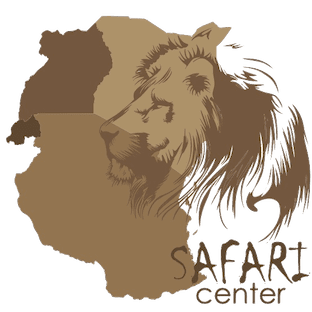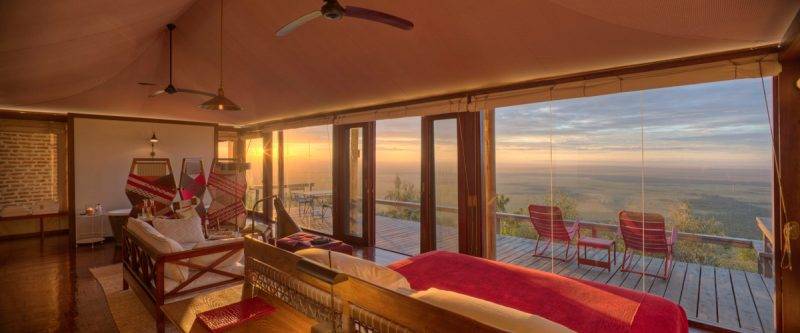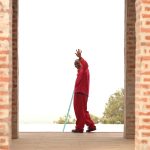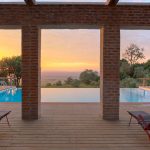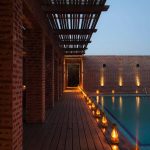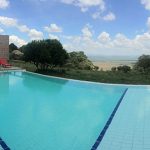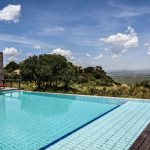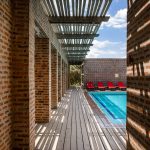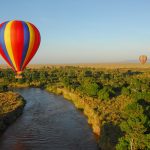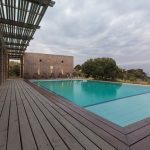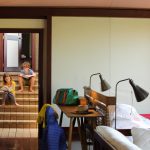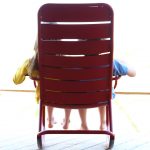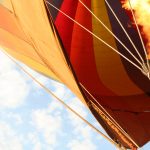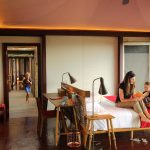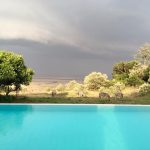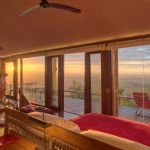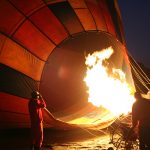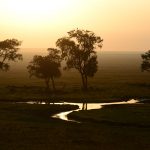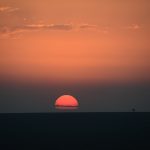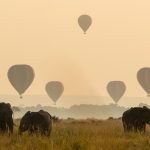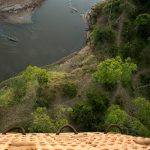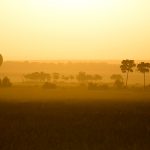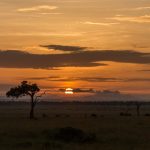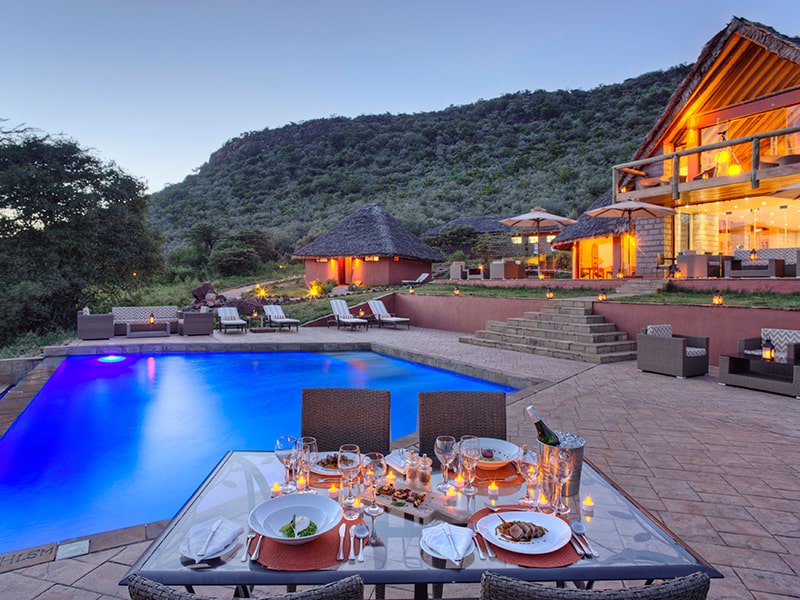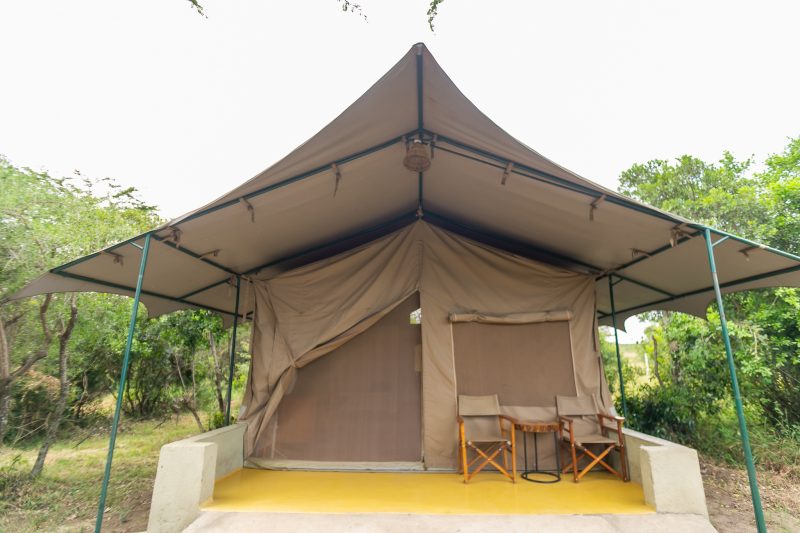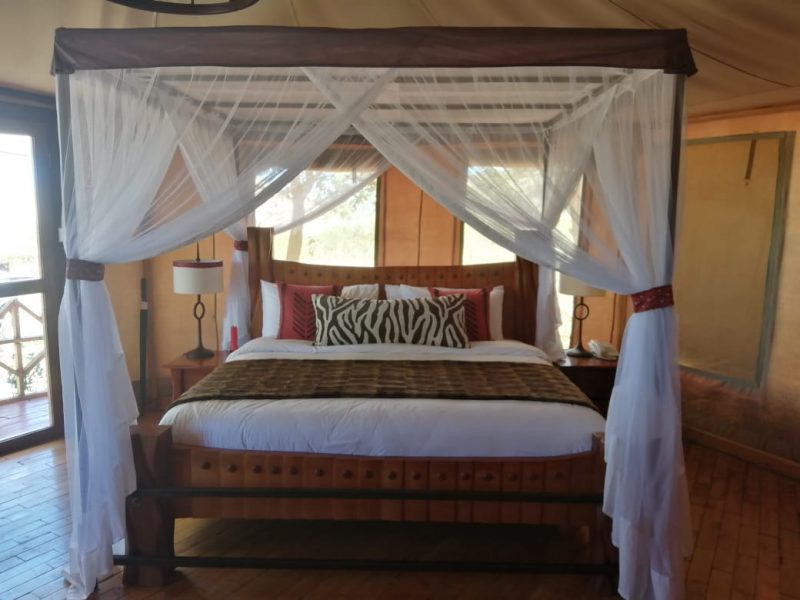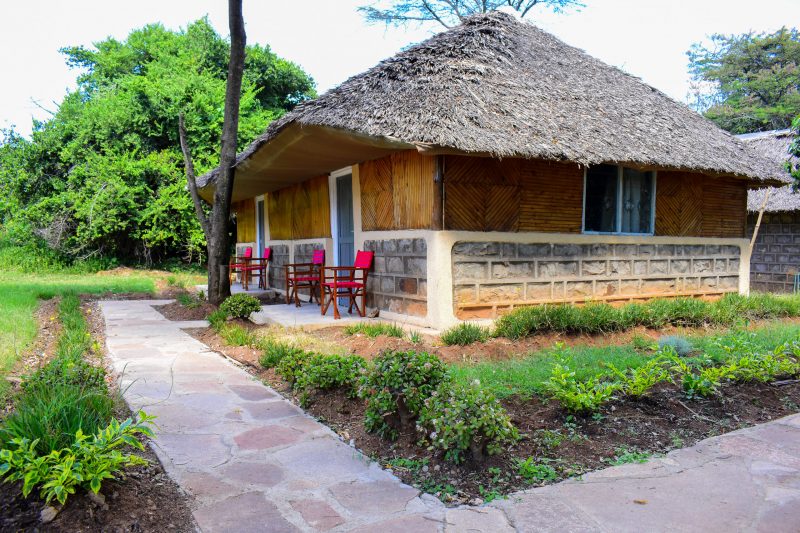Shs. 172,150/- ground package per person per night at Angama Mara
Valid until 30 September 2025
Ground packageDouble – Shs. 172,150/- per person per night Single – Shs. 258,230/- per night Min 2 nights |
Children0 to 6 – not allowed 6 to 12 years – please request for rates |
To book this package please fill out the following form or simply email us on safaris@safari-center.com
Angama Mara
Welcome to Angama Mara. It is a remarkable owner-run safari lodge. The name is a Swahili word for suspended in mid-air. The lodge is located high above the floor of Africa’s Great Rift Valley. Angama Mara overlooks Kenya’s Maasai Mara. It is the loveliest game reserve on the continent. Here guests will find a lodge where everything is as it ought to be. There are 2 intimate camps of 15 suites each. Angama has a private airfield and access to the Mara below. Angama Mara is in the heart of East Africa. It is easily accessible from major international airports. This combines perfectly with the safari highlights in the region.
About Angama Mara
Welcome to a remarkable new safari lodge, and a project more than ten years in the making. Balanced on the rim of Africa’s Great Rift Valley, Angama Mara is the brainchild of Steve & Nicky Fitzgerald, and draws on their considerable experience from developing and operating safari lodges whilst at the helm of &Beyond. More than anything, Angama brings together a fresh approach to both the safari experience and lodge design.
Best seat in the house
There is little that is conventional about the creation of Angama Mara, with views that stretch for miles across the Maasai Mara 300 meters below. It has two totally separate camps of just 15 tents each, every one with magnificent 180° views. The 2 camps are alongside one another, each with its own guest area, and kitchen. Each camp has two sets of interconnecting tents, perfect for families. The dramatic guest areas are for dining, drinking and lounging, and include a handsome brick-clad library. The Pavilion, set between the two camps, is home to the Safari Shop, a swimming pool, and the Fitness Room – guests never need to walk more than 10 minutes to go anywhere. The lodge is serviced by a private, hard-top airfield – just a 5-minute drive away.
Tented suites
Each tent has the same breathtaking view. Every day, the sunrise provides guests with early morning theatre as the hot air balloons float gently by. The glass frontage offers views from the bed, the bath, the sitting area, and the shower. The roof and other three sides are canvas. Each tented suite is over 100 sq.m. Decks are for in-room. Sleep with the sliding doors open. Highly polished parquet floors, distinctive splashes of Maasai red, a handsome drinks cabinet, vanity with double basins, separate w/c, writing desk with ample charging points and tablet with guest information, and WiFi, all add to the comfort and delight of guests in their suites. And because Angama Mara welcomes children of 6 years and older, the lodge has four sets of interconnecting tents, which allow children to move freely between their tent and their parents’ in complete safety and privacy.
Guest areas
Angama Mara’s architecturally dramatic guest areas were inspired by Nairobi’s Muthaiga Club. The inside of the guest areas become the outside and vice versa. There is no defined sitting room, dining room or bar. Extensive deck and baraza hanging off the edge of the Rift Valley. A dramatic shingle-clad drinks armoire welcomes guests. On lovely Mara days, all the action will be on the deck. By night, the softly-lit architecture of the Maasai brick walls and the cone-shaped buildings that float on a lily pond hold guests’ attention. Especially the library, a lovely quiet place and handsome brick-clad oval room, which is perfect for private dining, and complete with WiFi, and a thoughtfully chosen collection of books and films on Africa. The Pavilion is the only common shared area and sits in the heart of the lodge between the two camps.
Food
A great safari is also about great food. Almost more important than the food itself is where it is served. Inspired by what Denys Finch-Hatton’s camp chef might have cooked way back in the early days of being on safari, Angama Mara’s chefs prepare classic safari food. Our Kenyan chefs use only the best and freshest ingredients, celebrating the finest local produce for which the country is renowned: grass-fed beef, green beans, prawns from the coast – amongst many others. The result is food which is simple yet delicious; unfussy but oh-so-good to look at; and always generous and joyful and sometimes surprising.
Something for everyone
Angama Mara’s experienced guides tailor-make their guest’s safari days: first-timers to Africa will be guided differently to old-timers, and there are over 570-recorded species of birds which will keep birding enthusiasts busy. First and foremost, the guides are storytellers, and interpret the Mara in a way that immerses their guests in the surroundings: a safari at Angama Mara is about an overwhelming sense of place. Guests will have the opportunity to enjoy the knowledge and companionship of more than one guide as their desired safari experience changes from day to day, and the guiding team will endeavour to match like-minded guests with each other: birders will go on safari with fellow birders, as will those with a keen interest in photography or another special interest.
A day on safari
Guests could leave the lodge at dawn, or decide to go on a game drive after breakfast. Safaris are conducted in the lovely Mara Triangle, open from sunrise to sunset, and are in completely open game-viewing vehicles. Because the weather is so mild in the Mara, there are no constraints as to when to go on a game drive, and Angama Mara guests tailor-make their safari days: out early and back for breakfast; out early with a picnic breakfast and back for lunch; out after breakfast with a picnic lunch and back mid-afternoon; a post lunch game drive and back at sunset; or very best of all, spending a whole day exploring the Mara Triangle – with a picnic breakfast and lunch down at the Tanzanian border without a soul in sight – that’s an all-time favourite and a grand way to spend the day.
A rocking safari chair
Guests at Angama Mara can also enjoy the wonders of a safari without leaving the comfort of their deck: the views of the Mara from the tented suites are staggering – the sky never sits still and there is always something to spot 300m below – elephant families melting in and out of the forest, a thousand buffalo lazing about, giraffe stepping daintily down from the escarpment or a pod of hippo moving from one water body to the next. All the tents are equipped with binoculars and there is a spotting scope in the guest area. There are heaps of resident game around the lodge: eland, zebra, giraffe, topi and impala; and watching the raptors soar effortlessly above and below you is a great way to while away the hours.
Hot-air balloon
Enjoy one of the iconic experiences of Africa. Wake before dawn. A quick and straight-forward pre-flight briefing, and before you know it, the balloon is airborne. The soft, early morning breeze takes the balloon southwards towards the Tanzanian border, with the typical flight path along the Mara River and its adjoining forest, and over the open plains beyond. This is an unmatched safari – even the lions look up in surprise as one sails on by – and all the animals of the Mara are visible from the air. A flight normally lasts around one hour, and ends with a sometimes-bumpy landing amidst the termite mounds, all part of the adventure. Once you’ve settled back to earth, toast the morning’s activities with a celebratory champagne breakfast – specially prepared under a tree in the middle of nowhere. The perfect start to any day in the Mara, and for many, a once-in-a-lifetime experience.
Walking safaris
Many guests choose to discover the Great Rift Valley on foot. Maasai Naturalists offer guided walks. The birding up here is especially rewarding. Guests learn the traditional ways of the Maasai people from the Naturalists: local legends, fables, traditions, customs, the medicinal use of plants, and are often treated to singing and dancing along the way. All the while, lovely views of the Mara 300m below offer glimpses of great herds of buffalo, or a solitary elephant melting into the forest. Walking safaris at Angama Mara are tailor-made for every guest, and every fitness-level is taken into consideration. Depending on the time of day, and the length of walk, they can include picnic baskets, blankets, or even a lift back to the lodge. From a gentle 2-hour stroll to a full day’s walk, guests can choose exactly how they would like to discover the Rift Valley on foot.
The shamba
Shamba is a much-loved experience. it is within easy walking distance of the lodge. The shamba keepers welcome guests at the passionfruit arbor which forms the entrance and guide them through the 1-acre kitchen garden encouraging them to pick and taste along the way. The layout is reminiscent of snakes and ladders and the shamba keepers share the story behind its unique design. This is no ordinary vegetable patch. The lodge offers private shamba-to-table lunches in the garden under towering shady moth trees. Guests are free to pick their own ingredients which are then washed and readied for the freshest salads imaginable. Butlers prepare a wicker basket filled with loaves of bread, local cheese and chilled rosé wine to accompany the salads. Guests are left to while away the afternoon taking in sweeping views of the Mara below whilst watching the butterflies dance through the garden.
Photography
There is something about being in the Mara Triangle that simply forces you to grab your camera and catch that fleeting moment of beauty. The only real challenge here is to know when to put your camera down and just take in the moment, or snap it and keep it for always. Taking great pictures as an amateur photographer in the Mara is easy and fun thanks to the open rolling grasslands and the abundance of game throughout the year. And for guests who are either expert photographers or just passionate about taking wonderful images, the lodge will provide guides who understand photographic needs: where to place the vehicle for both the best light and the best angle; how to approach the animals so they don’t scare; and of course the patience needed to capture that one iconic photo of a male lion yawning in the early morning light.
Out of Africa
As a nod to the romantic tale that was filmed on the site of Angama Mara, the lodge offers intimate picnics for two on the crest of the Out of Africa kopje that is featured on the movie’s poster. A Maasai naturalist escorts guests up the hill to discover an old-world private picnic scene: checked blankets, comfy cushions, canvas safari chairs, a wicker picnic basket, sparkling wine on ice, coffee in a Stanley flask, elegant picnic food and of course, that view. Picnics can be enjoyed anytime of day: for breakfast soon after sunrise, or with evening sunset drinks as the sun sets behind. This experience is unique, and only to be found at Angama Mara. For those guests who love the movie or are hopeless romantics, this is surely the highlight of any stay.
Special moments
Angama Mara wedding
Couples marry in Maasai or traditional style with a group of friends or just the two of them, with the blessing performed by a local priest. There is a choice of beautiful locations on the property for this celebration, followed by a feast back at the lodge. The next morning newlyweds can toast their marriage with a private brunch for two on the Out of Africa kopje.
Maasai blessings
Couples either wanting to renew their vows or celebrate a milestone wedding anniversary can do this at an authentic, low-key sunset celebration in our Maasai boma or lovely Shamba. The husband is presented with a Maasai shirt and beaded walking stick and the wife with a traditional beaded skirt, top and beautiful Maasai jewelry. They arrive in the boma accompanied by singing and dancing maidens and warriors. After a performance by the warriors the elders will bless the couple.
Engagement
What could be more romantic than a proposal right on the site of the movie about one of the greatest love stories set in colonial Kenya? Out of Africa was filmed here and the little hill featured on the movie’s poster is where the lodge team sets up a champagne picnic on its crest, with sweeping views of the Mara below. With such a setting we have yet to have a refusal!
Birthdays
Whether it’s just a couple travelling together celebrating a milestone birthday, or the multi-generational gathering of a family clan, the lodge loves to throw a party. These take place in our Maasai Boma at sunset, accompanied by toasts with traditional Kenyan ‘dawa’ cocktails, a beautifully beaded Maasai gift is presented and the warrior performance dedicated to the birthday celebrant. For a more discreet celebration, guests can be surprised and spoiled by a champagne picnic for two on the crest of the Out of Africa kopje.
Bar Mitzvahs Maasai Style
During their Bar Mitzvah year, young Jewish men can celebrate their coming of age in the heart of Maasailand. The day starts with a wilderness walk in the company of a Maasai naturalist who will share his story about his Maasai journey from boyhood to manhood and teach him how to throw a spear and shoot with a bow and arrow. After a hearty breakfast, a couple of quiet hours are spent in a traditional manyatta in the Shamba with a Maasai elder, who will share his wisdom of this transition. The day is capped in an evening ceremony, when the young man is the guest of honour in the boma and dances with the Maasai warriors, before being blessed by the elders and presented with a special gift to celebrate his coming of age, and commemorate this special day.
Just relax
For those wanting to take things a little easier, a masseuse offers full-body massages on the tent’s deck; or indulge in a rocking chair safari – each tent has two comfy bright red rocking chairs, from which you can enjoy the parade of wildlife in the Mara spread out below. In the guest areas, there is a lovely stand-alone library offering a carefully curated selection of Africana literature and film. Both the tented suites and the library, with its fireplace, leather sofa and refectory table are covered by a high-speed WiFi network.
Work up a sweat
For those wanting to expend some energy, Angama Mara has a beautiful swimming pool (12m x 6m) with rim-flow views of the Mara below and beyond. The pool was designed with families and sun-lovers in mind, and is court-yarded on three sides. Alongside the pool is the lodge’s Fitness Room, once again with floor-to-ceiling glass stacking-doors to enjoy the view. Guests can choose from ellipticals, treadmills and bicycles, yoga, Pilates balls and a ballet bar for stretching.
Be our guest
There is also much to experience in and around the lodge: Angama Mara’s Safari Shop offers guests the opportunity to browse through a curated selection of Kenyan and African jewellery, fashion, artifacts and literature. Leading off from the shop is a Maasai craft studio, where guests can try their hand at beading or even perhaps have Maasai ladies bead a bespoke item onto their clothing. This is the perfect place for children to pass a few hours. Angama Mara’s property spreads over 300 hectares and guests are welcome to stroll through the staff village, past the zebra and giraffe, to the lodge’s community clinic, say hello to the doctor or pop into the community duka and buy a cold Tusker.
The Maasai
According to their own oral history, the Maasai people’s origins are in the Nile Valley region, before they moved south around 300 years ago, conquering other tribes and living as nomadic pastoralists. The region is what is now called South Sudan. In spite of many interventions, the Maasai have retained their traditions and remained a proud and indomitable people. Their tall stature, red shukas, rungu sticks and ornate beadwork are among their hallmarks. Maasai society is strongly patriarchal. The women are responsible for the construction of the homestead manyattas, made from mud, stick and dung. The men build the surrounding engang of thorn branches. They keep livestock safe within the home compound. The actual population of Maasai is not clear. But there are perhaps half a million living in various sub-tribes unified by the Maa language.
Maasai culture
You can interact with the Maasais. Every evening at sunset, Maasai warriors perform in the lodge’s traditional bush-packed boma. In Angama Mara’s craft studio, guests can try their hand at Maasai craft, as skilled ladies bead bespoke items onto pieces of clothing, and we have also had the privilege of hosting Maasai weddings, vow renewals, Olympics, and even a Maasai Mitzvah for one lucky young guest. In the heart of Maasailand, Angama Mara is surrounded by many traditional homestead manyattas that welcome travellers. Here, guests enjoy a rare opportunity of gaining a deeper understanding into the every day lives of the Maasai, their ways, their fascinating culture and what daily challenges they face in maintaining the fine balance between preserving their ancient ways and embracing the new. Guests may freely photograph the family and their homesteads and buy beautiful traditional jewelry directly from the ladies who craft it.
The Maasai Mara
The Mara is affectionately known as Africa’s loveliest game reserve. It forms the northernmost limit of the greater Serengeti-Mara ecosystem. Here roams an abundance of Africa’s game. Mara is a year-round destination. It has a temperate climate and seasons dictated by rainfall. The Mara never fails to deliver. It is a breathtaking setting for wildlife photographers and safari enthusiasts. First-timers and seasoned travellers like them too. Maasai Mara is named in honour of the Maasai people. They call this corner of Africa home. The Mara is world renowned for its exceptional populations of lion, leopard and cheetahs. Herds of buffalo, the rare black rhino and of course the thriving elephants are also in abundance. In approximately July of each year, the Great Migration arrives. It stays on for an about four months.
The Mara triangle
There is an area west of the Mara River. It is situated beneath the Oloololo escarpment. The place is known as the Mara Triangle. Not only is this the most productive part of the entire Serengeti-Mara ecosystem in terms of grass nutrition, but it is also spectacularly scenic. In places, the grassy plains are dotted with widely spaced Balanites trees. This give the landscape an almost manicured look. The Mara Triangle has been most efficiently managed by the Mara Conservancy for the past 15 years.
Climate in the Mara
Just a few degrees south of the equator, there are only minor fluctuations in the length of day and temperature over the year. What does vary however, is the rainfall. There are two distinct seasons. The long rains happen from mid-March through June. And the short rains happen during the months of November and early December. Clear bright mornings are the norm throughout most of the year, and in season, the rain tends to arrive in the afternoon and evening. Far from being a depressing event, the rain in the Mara is a life force. To be out in the midst of it – on the plains amongst the wildlife – is to be in the middle of nature’s celebration, and the approach of a storm is spectacular, with its darkening sky and accompanying lightning and thunder.
The Serengeti-Mara ecosystem
The great migration is defined by the annual movement of over two million migratory wildebeest. These seasonal wanderers are just one element of the greater Serengeti-Mara ecosystem. Numerous distinct habitat types exist. The soil type and rainfall are the main influences. The ecosystem is driest in the southeast and wettest in the northwest – the Mara Triangle. South of the Kenyan border lies Tanzania’s Serengeti. It consists of various types of woodland and grassland. It is on the ‘short-grass plains’. The area is made up of shallow, volcanic soils west of Ngorongoro. And that is where the wildebeest’s story begins. Here, they give birth to young calves every January and February. These plains flush green with highly nutritious grass after the rain. But they are grazed flat and dry-out completely by March when the herds trek north.
A year-round affair
For guests wanting to experience the Great Migration and the dramatic crossings of the Mara River, July through September or October are the best months to visit. Others prefer a gentler time with less visitors and enjoy the Mara all by themselves – together with the numerous resident herds which quite rightly do not deem it necessary to leave this beautiful reserve by embarking on the annual trek to Tanzania. Maasai Mara is full of prides of lions and other members of Africa’s Big Five – leopard, elephant, buffalo and black rhino.
Where it all began
Fly north from Angama Mara, and discover the limitless, endless land that is northern Kenya. Fly east from Angama Mara, towards Mt Kilimanjaro, and explore the Green Chyulu Hills that inspired Hemingway, and capture that iconic photograph of an elephant in Amboseli. South from Angama Mara is the heart of the mighty Serengeti. Fly west from Angama Mara, to Africa’s great lakes and the countries of Rwanda and Uganda. Here safari travellers will have a-once-in-a-lifetime experience observing some of the world’s last remaining mountain gorillas, protected in their natural habitat.
Safari philosophy
The pace is a little slower here. They might start their safari in the Mara and want to do many game drives; they might come here in the middle of their journey and do a little less game viewing; or they might end their adventure at Angama Mara and only go down into the Reserve to find something they might not have seen. One fact for certain is that the Mara Triangle consistently delivers twelve months of the year – so one can afford to take things a little slower, and enjoy a much more flexible day on safari no matter what time of year.
